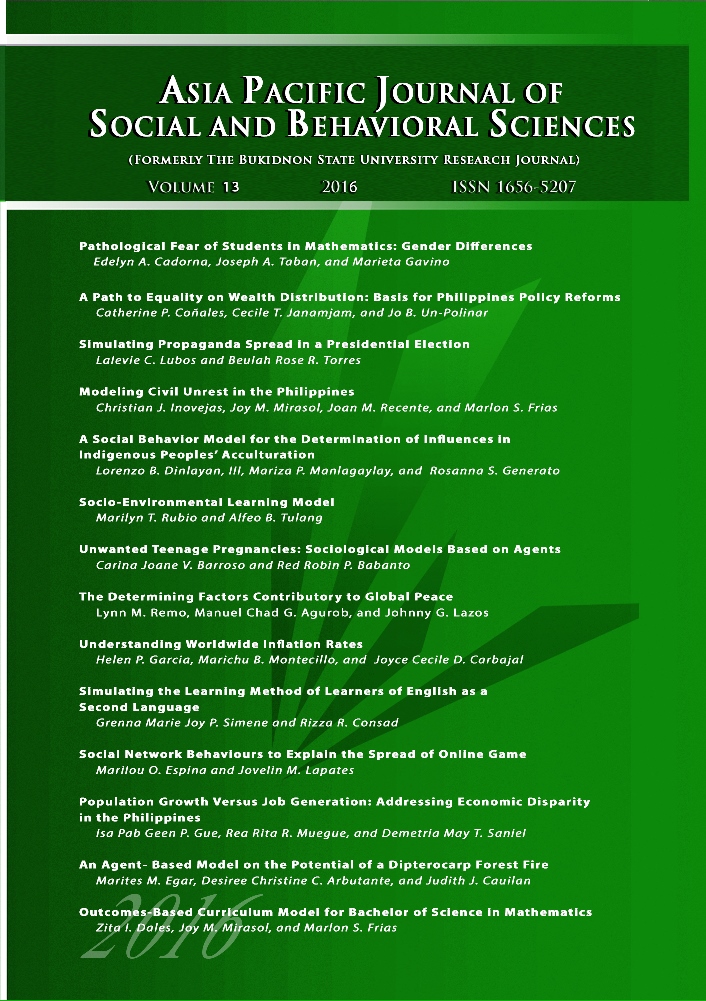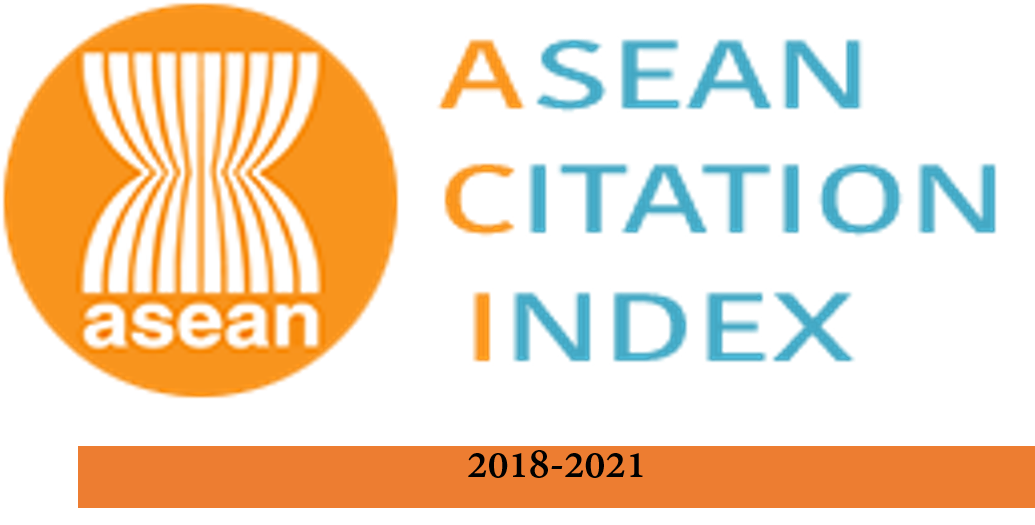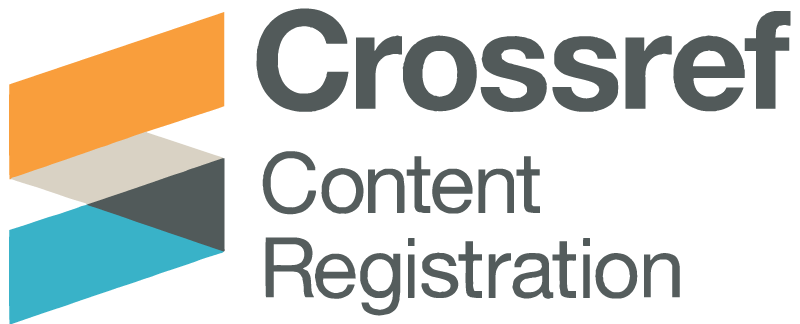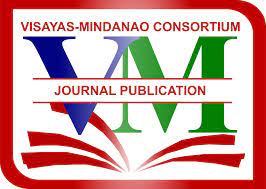Pathological Fear of Students in Mathematics: Gender Differences
Abstract
The study explored the pathological fear in Mathematics of male and female college students. The study utilized the mixed method of research with 199 first year non-Math students as participants to determine the causes, effects, and ways of overcoming this fear. It made use of the cross-sectional design to explore the strategies of overcoming this pathological fear among the students. Results revealed that the students fear Math because of the influence of their friends, personal capacity, and the complex nature of Math. The male and female students differ in the prime cause of pathological fear. The cause as identified for the males is nature of the subject while personal capacity for the females. The students’ fear in Mathematics affects their performance in the subject. The main effect of the students’ fear in Math is recalling what had been learned when preparing for an examination. As a way of overcoming this fear, the female students cited that the teaching of mathematics should be made enjoyable. The male students suggested that they should be taught how mathematics is applied in everyday life situations. The students also need their parent support, encouragement, and motivation. On the part of the teachers, the students suggest the use of appropriate teaching strategies to make mathematics learning more meaningful.
Keywords:
Pathological Fear, Mathematics, Gender Differences, Mixed Method
References
Alexander, A.H. (2010). Effective teaching strategies for alleviating math anxiety and increasing self-efficacy in secondary students (Master’s thesis). Retrieved March 30, 2015, from http://www.evergreen.edu
Cadorna, E.A., et al. (2013). Mathematics anxiety and physics performance of non-physics majors. Philippine Physics Journal, 35. Retrieved March 30, 2015 from HTTP://philippinephysicssociety.org/resources/PPJ+complete+$28volume+1-35$29.pdf
Emenalo, S.I. (2006). Mathematics phobia: causes, treatment, and prevention. Inter-national Journal of Mathematical Education In Science And Technology, 15 (4), 447-459. Retrieved March 20, 2015, from doi: 10.1080/0020739840150405
Foa, E. B., & Kozak, M. J. (1985). Treatment of anxiety disorders: Implications for psy-chopathology. In B.O. Rothbaun (Eds.), Pathological anxiety: Emotional processing in etiology and treatment. Guilford Publishing. Retrieved March 3, 2016 athttps://www.guilford.com/excerpts/rothbaum.pdf
Foa, E. B., & Kozak, M. J. (1986). Emotional processing of fear: Exposure to corrective information. In B.O. Rothbaun (Eds.), Pathological anxiety: Emotional processing in etiology and treatment. Guilford Publishing. Retrieved March 3, 2016 at https://www.guilford.com/excerpts/rothbaum.pdf
Furner, J., & Bernan, B. (2003). Math anxiety: Overcoming a major obstacle to the improvement of student math performance (Electronic version). Association for Child-hood Education International. Retrieved on March 30, 2015 at http://www.coe.fau.edu/centersandprograms/mathitudes/documents/MathAnxietyResearchPaper2.pdf
Hembree, R. (1990). Nature, effects, and relief of mathematics anxiety. Journal of Research in Mathematics Education, 21(1), 33-46. Retrieved August 15, 2016, from doi: 10.2307/749455
Ho, H. et al. (2000). The affective and cogni-tive dimensions of math anxiety. Journal in Mathematics Education, 31 (3). Retrieved on January 10, 2016 at http://archives.evergreen.edu/masterstheses/Accession89-10MIT/Hellum-Alexander_AMIT2010.pdf
Jain, S., & Dowson, M. (2009). Mathematics anxiety as a function of multi-dimensional self-regulation and self-efficacy. Contemporary Educational Psychology, 34(3), 240-249. Retrieved August 8, 2016 from March 30, 2015, doi: 10.1016/j.cedpsych.2009.05.004
Mizell, A. (2015, July 30). Paradigm Shift/The need to prepare students with skills for the 21st century. Mindanao Times. Retrieved from http://mindanaotimes.net/paradigm-shift-the-need-to-prepare-students-with-skills-for-the-21st-century/Perception of students on the cause and effect of Mathematics anxiety among students of tertiary institutions in Nigeria: A case study of UAM. (n.d.). In ResearchClue.com. Retrieved from http://nairaproject.com/projects/1370.html
Phillips, M.C. (2015). The causes and prevention of math anxiety. 2015. Retrieved March 20, 2015, from http://www.mathgoodies.com/articles/math_anxiety.html
Rossman, S. (2006). Overcoming math anxiety. Mathetudes, 1 (1), 1-4. Retrieved March 15, 2016, from http://www.coe.fau.edu/centersandprograms/mathitudes/documents/Math%20Anxiety%20Research%20Paper%202.pdf.
Cadorna, E.A., et al. (2013). Mathematics anxiety and physics performance of non-physics majors. Philippine Physics Journal, 35. Retrieved March 30, 2015 from HTTP://philippinephysicssociety.org/resources/PPJ+complete+$28volume+1-35$29.pdf
Emenalo, S.I. (2006). Mathematics phobia: causes, treatment, and prevention. Inter-national Journal of Mathematical Education In Science And Technology, 15 (4), 447-459. Retrieved March 20, 2015, from doi: 10.1080/0020739840150405
Foa, E. B., & Kozak, M. J. (1985). Treatment of anxiety disorders: Implications for psy-chopathology. In B.O. Rothbaun (Eds.), Pathological anxiety: Emotional processing in etiology and treatment. Guilford Publishing. Retrieved March 3, 2016 athttps://www.guilford.com/excerpts/rothbaum.pdf
Foa, E. B., & Kozak, M. J. (1986). Emotional processing of fear: Exposure to corrective information. In B.O. Rothbaun (Eds.), Pathological anxiety: Emotional processing in etiology and treatment. Guilford Publishing. Retrieved March 3, 2016 at https://www.guilford.com/excerpts/rothbaum.pdf
Furner, J., & Bernan, B. (2003). Math anxiety: Overcoming a major obstacle to the improvement of student math performance (Electronic version). Association for Child-hood Education International. Retrieved on March 30, 2015 at http://www.coe.fau.edu/centersandprograms/mathitudes/documents/MathAnxietyResearchPaper2.pdf
Hembree, R. (1990). Nature, effects, and relief of mathematics anxiety. Journal of Research in Mathematics Education, 21(1), 33-46. Retrieved August 15, 2016, from doi: 10.2307/749455
Ho, H. et al. (2000). The affective and cogni-tive dimensions of math anxiety. Journal in Mathematics Education, 31 (3). Retrieved on January 10, 2016 at http://archives.evergreen.edu/masterstheses/Accession89-10MIT/Hellum-Alexander_AMIT2010.pdf
Jain, S., & Dowson, M. (2009). Mathematics anxiety as a function of multi-dimensional self-regulation and self-efficacy. Contemporary Educational Psychology, 34(3), 240-249. Retrieved August 8, 2016 from March 30, 2015, doi: 10.1016/j.cedpsych.2009.05.004
Mizell, A. (2015, July 30). Paradigm Shift/The need to prepare students with skills for the 21st century. Mindanao Times. Retrieved from http://mindanaotimes.net/paradigm-shift-the-need-to-prepare-students-with-skills-for-the-21st-century/Perception of students on the cause and effect of Mathematics anxiety among students of tertiary institutions in Nigeria: A case study of UAM. (n.d.). In ResearchClue.com. Retrieved from http://nairaproject.com/projects/1370.html
Phillips, M.C. (2015). The causes and prevention of math anxiety. 2015. Retrieved March 20, 2015, from http://www.mathgoodies.com/articles/math_anxiety.html
Rossman, S. (2006). Overcoming math anxiety. Mathetudes, 1 (1), 1-4. Retrieved March 15, 2016, from http://www.coe.fau.edu/centersandprograms/mathitudes/documents/Math%20Anxiety%20Research%20Paper%202.pdf.










